Why you need to ask yourself 'Is Your Workout Routine Balanced?'
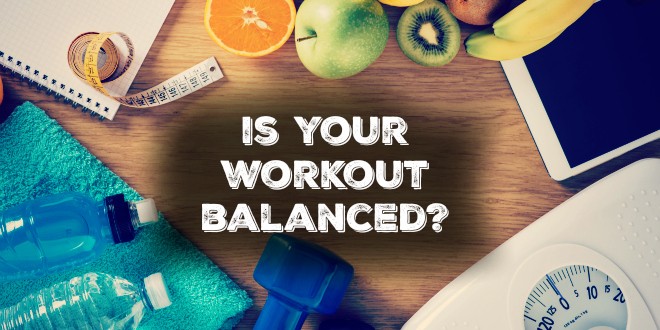
[caption id="attachment_21181" align="alignright" width="334"] ![Do you remember this guy? Billy Blanks' Tae Bo program was huge! [image credit: TaeBo.com]](https://cdn.proshark.com/daimanuel/2015/12/taebo.jpg) Do you remember this guy? Billy Blanks' Tae Bo program was huge! [image credit: TaeBo.com][/caption] Fads or buzz words and phrases come and go quickly in the fitness industry. For example, does anyone remember Tae Bo?
If you are about 35-40 years old or older you might.
Do you remember this guy? Billy Blanks' Tae Bo program was huge! [image credit: TaeBo.com][/caption] Fads or buzz words and phrases come and go quickly in the fitness industry. For example, does anyone remember Tae Bo?
If you are about 35-40 years old or older you might.
Billy Blanks most likely made MILLIONS in maybe a 24-month span about 20 years ago when EVERY gym and fitness center across the nation began canceling step classes to make room in their aerobics class schedules for Tae Bo. Be honest and ask yourself, when was the last time you heard the name Tae Bo?
Every once in a while a fad shows legs and has some staying power on our collective fitness ADD. Spin classes would be a fine example and it is looking like the TRX has a strong enough following that it’s not going anywhere soon. Specifically however, I want to touch on something that has graduated from fad status of 15-ish years ago and become the norm today, core training. Specifically an aspect of core training that in my opinion gets often ignored, proprioception.
I think the easiest way to explain what proprioception is would be to say it is your ability to know where a body part is in space without having to look .
[caption id="attachment_21185" align="aligncenter" width="550"]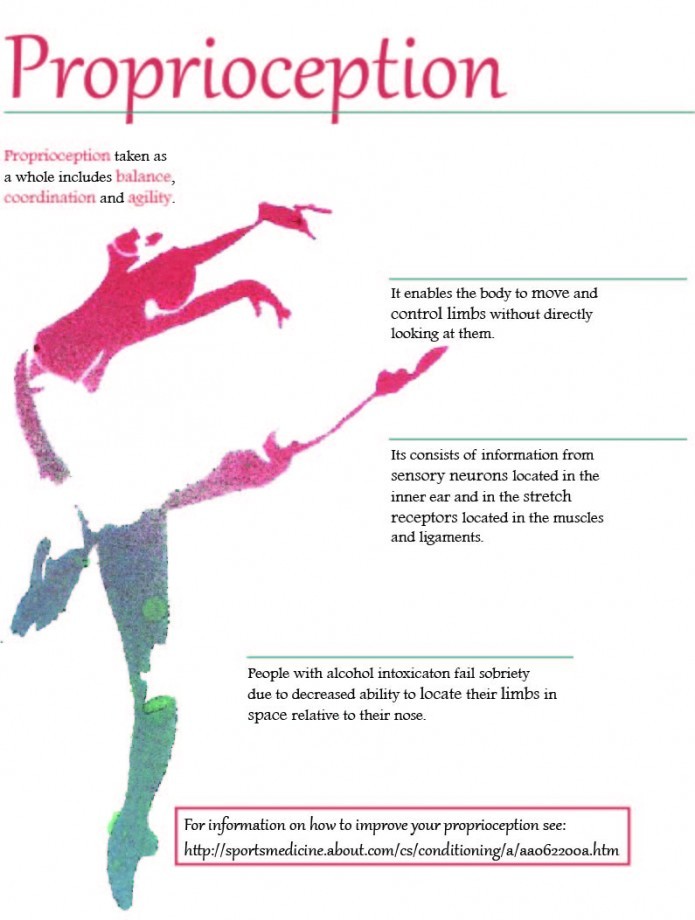 Proprioception explained [image credit - click here
][/caption]Sensory and motor nerves called proprioceptors send and receive signals dealing with muscle tension and relative position of a body part in motion. So in other words, it controls balance, coördination and agility
. What I really want to hone in on is the importance of balance training
while you lose weight.
Proprioception explained [image credit - click here
][/caption]Sensory and motor nerves called proprioceptors send and receive signals dealing with muscle tension and relative position of a body part in motion. So in other words, it controls balance, coördination and agility
. What I really want to hone in on is the importance of balance training
while you lose weight.
Obesity plays a huge factor in how efficiently the body executes everyday tasks like bending, stooping, kneeling, carrying and lifting for several reasons. Studies show balance can be affected due to motor delays as a result of increased inertia of body limbs, range of motion and strength limitations. The body will physically adapt to an increase of mass which commonly results in muscle weakness or fatigue, abnormal gait patterns and impaired balance. It just so happens that those are the top three risk factors that contribute to falls in older adults.
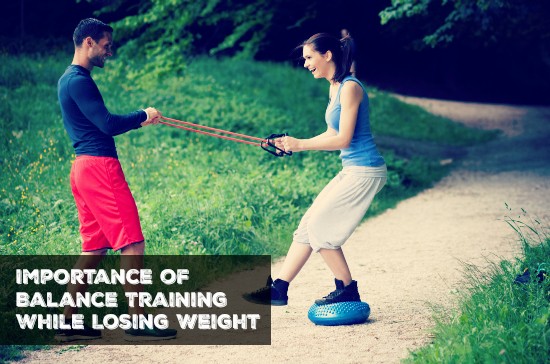
Let’s take a second to think about the act of just standing.
In order to support balance, we as humans need to keep our center of mass, or maybe more commonly called center of gravity, directly over our base of support. If our center of mass is not directly over our base of support, then we are off-balance and we fall over. Simple enough? In theory yes, but if we look at the physics of it, maybe not. Let’s break it down.
If I measure my normal everyday average stance, my base of support is roughly 13” x 17” or 221 sq” keep in mind that I am 6’0” tall and weigh around 190 lbs. So picture a column that is narrower at the base than the top, weighing 190 lbs, six feet in the air on a base that is smaller than a foot and a half by a foot and a half and the center of mass of that column is going to be around three and a half feet off of the deck. It doesn’t sound too stable when you look at it that way does it?
[caption id="attachment_21188" align="alignleft" width="329"] A fine example of having great proprioception - the kung fu finger pushup. Don't try this at home.[/caption]
A fine example of having great proprioception - the kung fu finger pushup. Don't try this at home.[/caption]
Now think about those same dimensions but add 75-100 lbs of mass to it. The base will stay the same, 221sq”, but the top of the base will become wider and more top-heavy as well as the center of mass changing position. Let’s think about this for a second. Body mass goes up which is easy to physically see, i.e., bigger belly, resulting in the center of mass being carried more forward than normal. So if the center of mass has shifted more forward over the toes, naturally we can expect an increase of torque at the ankle just to maintain a static position so that we can keep our balance and not fall forward.
Along with a change in biomechanics, there will also be chronic postural changes taking place due to the added mass. Gravity will pull down on that large tummy causing the pelvis to abnormally rotate forward putting stress on the lower back. It is pretty common to see the arches of the foot collapsing when a larger person takes a step or even squats. When the arch of the foot collapses, the foot will go through eversion which will affect the ankle. This in turn will cause issues at the knee with proper tracking and alignment.
Consistently the most common anatomical deviations due to obesity occur at the feet/ankles, the knees and the spine. It’s not hard to see how basic movement functions are compromised due to obesity, as well as the most common sites where pain occurs.
Now back to the original point of the importance of balance training as you lose weight. I have just outlined some of the issues that affect basic biomechanical function including balance. Now as you lose weight and build muscle mass, the body will naturally change and move back towards normal postural alignment. As those changes take place, center of gravity will shift. All of these changes happening at once can change your sense of balance and proprioception. Weight loss alone will, in fact, bring about improvements in postural balance for overweight people. However, combining weight reduction with resistance training has proven to bring about much more significant gains in improved balance than weight loss alone.
In my experience, core specific training and balance go hand in hand. Without a strong core it is a challenge to hold your body statically in a difficult position for any length of time. Anyone who has had a go at yoga can attest to this fact. Now I am not saying you need to go to a yoga class to improve your balance. I do, however personally endorse attending yoga classes as a great and viable option for improving both balance and flexibility , but it’s not for everyone.
We are all busy folks and I know you are sitting there reading this thinking, “Oh great! One more thing to add to my already long workout???”
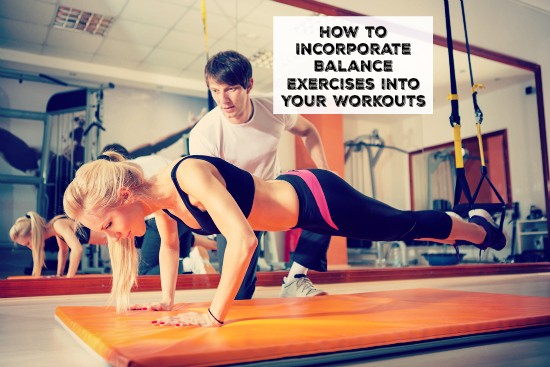
Not to worry! With a little creativity, balance training can be easily combined with your regular workout. Let’s use dumbbell curls for instance. It is VERY common to do them sitting on an incline bench. We have all seen it and I do them in this fashion on a fairly regular basis. If you think about it, you are essentially sitting in a rigid back chair that is supporting your body, so you can deduce that the chair is acting like a brace or a crutch for your core.
Now if we do that same exercise, a dumbbell curl, while standing up, we no longer have the assistance of that rigid chair back helping to hold the core in a fixed static position. So in fact, just by standing up we are working more of our core while we are performing a movement specifically targeting the biceps.
[caption id="attachment_21187" align="alignright" width="330"]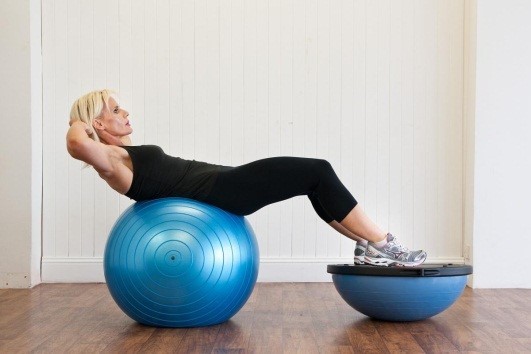 Try a bosu
or balance ball
to spice up your next workout[/caption]
Try a bosu
or balance ball
to spice up your next workout[/caption]
Let’s raise the ante a bit and bring a balance challenge into the equation. Let’s throw a BOSU or Stability Pods into the mix. Try standing on either of these and perform dumbbell curls. You will find that to maintain balance on them while performing curls will force you to engage your core big time and need a fair amount of concentration and focus as well. You were going to do curls anyway, right?
Just like that you got some quality balance training in and didn’t have to add anything to your workout!
[divider style="dashed" top="15" bottom="15"]
Tim is a full-time gym manager/personal trainer, part-time gym designer, part-time blogger and part-time psuedo-entertaining public speaker as well as an ex-college athlete and ex-firefighter with a BS Degree from Fresno State in Kinesiology as well as an AS degree in Respiratory Therapy. His passion is seeing everyday people get healthy and live life to the fullest.
“My heart breaks for those that want to get healthy but are too intimidated to go to a gym. I strive to break those barriers and bring the vast and complex world of fitness to the common man. I love working with people fresh off the couch and turning them on to a life of health and fitness! It is a HUGE reward to get to be a small part of giving someone a second chance at living! To be more specific I LOVE to see someone like that have their ‘AH-HA!’ moment and realize there is an athlete within. That is my passion and my pay off. That is what drives me to do what I do.”
Tim can be followed via: Facebook , LinkedIn, the Community Medical Center Fit for Life Blog or reached directly by email at tclark@communitymedical.org
![Do you remember this guy? Billy Blanks' Tae Bo program was huge! [image credit: TaeBo.com]](https://cdn.proshark.com/daimanuel/2015/12/taebo.jpg) Do you remember this guy? Billy Blanks' Tae Bo program was huge! [image credit: TaeBo.com][/caption] Fads or buzz words and phrases come and go quickly in the fitness industry. For example, does anyone remember Tae Bo?
If you are about 35-40 years old or older you might.
Do you remember this guy? Billy Blanks' Tae Bo program was huge! [image credit: TaeBo.com][/caption] Fads or buzz words and phrases come and go quickly in the fitness industry. For example, does anyone remember Tae Bo?
If you are about 35-40 years old or older you might.Billy Blanks most likely made MILLIONS in maybe a 24-month span about 20 years ago when EVERY gym and fitness center across the nation began canceling step classes to make room in their aerobics class schedules for Tae Bo. Be honest and ask yourself, when was the last time you heard the name Tae Bo?
Every once in a while a fad shows legs and has some staying power on our collective fitness ADD. Spin classes would be a fine example and it is looking like the TRX has a strong enough following that it’s not going anywhere soon. Specifically however, I want to touch on something that has graduated from fad status of 15-ish years ago and become the norm today, core training. Specifically an aspect of core training that in my opinion gets often ignored, proprioception.
What is Proprioception?
I think the easiest way to explain what proprioception is would be to say it is your ability to know where a body part is in space without having to look .
[caption id="attachment_21185" align="aligncenter" width="550"]
 Proprioception explained [image credit - click here
][/caption]Sensory and motor nerves called proprioceptors send and receive signals dealing with muscle tension and relative position of a body part in motion. So in other words, it controls balance, coördination and agility
. What I really want to hone in on is the importance of balance training
while you lose weight.
Proprioception explained [image credit - click here
][/caption]Sensory and motor nerves called proprioceptors send and receive signals dealing with muscle tension and relative position of a body part in motion. So in other words, it controls balance, coördination and agility
. What I really want to hone in on is the importance of balance training
while you lose weight.Importance of Balance Training while Losing Weight
Obesity plays a huge factor in how efficiently the body executes everyday tasks like bending, stooping, kneeling, carrying and lifting for several reasons. Studies show balance can be affected due to motor delays as a result of increased inertia of body limbs, range of motion and strength limitations. The body will physically adapt to an increase of mass which commonly results in muscle weakness or fatigue, abnormal gait patterns and impaired balance. It just so happens that those are the top three risk factors that contribute to falls in older adults.

Let’s take a second to think about the act of just standing.
In order to support balance, we as humans need to keep our center of mass, or maybe more commonly called center of gravity, directly over our base of support. If our center of mass is not directly over our base of support, then we are off-balance and we fall over. Simple enough? In theory yes, but if we look at the physics of it, maybe not. Let’s break it down.
If I measure my normal everyday average stance, my base of support is roughly 13” x 17” or 221 sq” keep in mind that I am 6’0” tall and weigh around 190 lbs. So picture a column that is narrower at the base than the top, weighing 190 lbs, six feet in the air on a base that is smaller than a foot and a half by a foot and a half and the center of mass of that column is going to be around three and a half feet off of the deck. It doesn’t sound too stable when you look at it that way does it?
[caption id="attachment_21188" align="alignleft" width="329"]
 A fine example of having great proprioception - the kung fu finger pushup. Don't try this at home.[/caption]
A fine example of having great proprioception - the kung fu finger pushup. Don't try this at home.[/caption]Now think about those same dimensions but add 75-100 lbs of mass to it. The base will stay the same, 221sq”, but the top of the base will become wider and more top-heavy as well as the center of mass changing position. Let’s think about this for a second. Body mass goes up which is easy to physically see, i.e., bigger belly, resulting in the center of mass being carried more forward than normal. So if the center of mass has shifted more forward over the toes, naturally we can expect an increase of torque at the ankle just to maintain a static position so that we can keep our balance and not fall forward.
Along with a change in biomechanics, there will also be chronic postural changes taking place due to the added mass. Gravity will pull down on that large tummy causing the pelvis to abnormally rotate forward putting stress on the lower back. It is pretty common to see the arches of the foot collapsing when a larger person takes a step or even squats. When the arch of the foot collapses, the foot will go through eversion which will affect the ankle. This in turn will cause issues at the knee with proper tracking and alignment.
Consistently the most common anatomical deviations due to obesity occur at the feet/ankles, the knees and the spine. It’s not hard to see how basic movement functions are compromised due to obesity, as well as the most common sites where pain occurs.
As You Lose Weight, What Happens to Your Balance?
Now back to the original point of the importance of balance training as you lose weight. I have just outlined some of the issues that affect basic biomechanical function including balance. Now as you lose weight and build muscle mass, the body will naturally change and move back towards normal postural alignment. As those changes take place, center of gravity will shift. All of these changes happening at once can change your sense of balance and proprioception. Weight loss alone will, in fact, bring about improvements in postural balance for overweight people. However, combining weight reduction with resistance training has proven to bring about much more significant gains in improved balance than weight loss alone.
In my experience, core specific training and balance go hand in hand. Without a strong core it is a challenge to hold your body statically in a difficult position for any length of time. Anyone who has had a go at yoga can attest to this fact. Now I am not saying you need to go to a yoga class to improve your balance. I do, however personally endorse attending yoga classes as a great and viable option for improving both balance and flexibility , but it’s not for everyone.
How to Incorporate Balance Exercises into Your Workouts
We are all busy folks and I know you are sitting there reading this thinking, “Oh great! One more thing to add to my already long workout???”

Not to worry! With a little creativity, balance training can be easily combined with your regular workout. Let’s use dumbbell curls for instance. It is VERY common to do them sitting on an incline bench. We have all seen it and I do them in this fashion on a fairly regular basis. If you think about it, you are essentially sitting in a rigid back chair that is supporting your body, so you can deduce that the chair is acting like a brace or a crutch for your core.
Now if we do that same exercise, a dumbbell curl, while standing up, we no longer have the assistance of that rigid chair back helping to hold the core in a fixed static position. So in fact, just by standing up we are working more of our core while we are performing a movement specifically targeting the biceps.
[caption id="attachment_21187" align="alignright" width="330"]
 Try a bosu
or balance ball
to spice up your next workout[/caption]
Try a bosu
or balance ball
to spice up your next workout[/caption]Let’s raise the ante a bit and bring a balance challenge into the equation. Let’s throw a BOSU or Stability Pods into the mix. Try standing on either of these and perform dumbbell curls. You will find that to maintain balance on them while performing curls will force you to engage your core big time and need a fair amount of concentration and focus as well. You were going to do curls anyway, right?
Just like that you got some quality balance training in and didn’t have to add anything to your workout!
[divider style="dashed" top="15" bottom="15"]
 Author Bio: Tim Clark
Author Bio: Tim Clark
Tim is a full-time gym manager/personal trainer, part-time gym designer, part-time blogger and part-time psuedo-entertaining public speaker as well as an ex-college athlete and ex-firefighter with a BS Degree from Fresno State in Kinesiology as well as an AS degree in Respiratory Therapy. His passion is seeing everyday people get healthy and live life to the fullest.
“My heart breaks for those that want to get healthy but are too intimidated to go to a gym. I strive to break those barriers and bring the vast and complex world of fitness to the common man. I love working with people fresh off the couch and turning them on to a life of health and fitness! It is a HUGE reward to get to be a small part of giving someone a second chance at living! To be more specific I LOVE to see someone like that have their ‘AH-HA!’ moment and realize there is an athlete within. That is my passion and my pay off. That is what drives me to do what I do.”
Tim can be followed via: Facebook , LinkedIn, the Community Medical Center Fit for Life Blog or reached directly by email at tclark@communitymedical.org




































































































